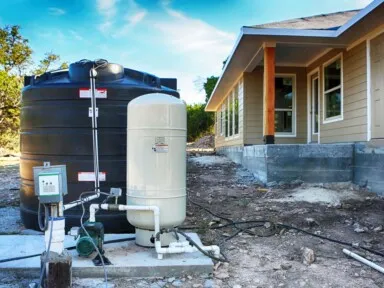Whether you dug a well yourself or have a home with a pre-existing well, well water is a part of daily life for many people. But do you know where it comes from? Long before it enters wells, groundwater collects through underground aquifers where it is naturally filtered. The wells are what tap into this incredible natural water source.
As one of the oldest human inventions that we know of, wells have been used by people throughout history. So, how does this ancient technology work today? Is it the same?
In this article:
- The Source of Well Water
- How is Well Water Accessed?
- Factors Affecting Well Water Quality
- City vs. Well Water
- Challenges of Using Well Water
- Well Water Testing and Filtration
- Frequently Asked Questions
The Source of Well Water
Understanding where well water comes from is all about knowing how natural aquifer systems work. Technically, most well water will come from groundwater, but that groundwater is stored in aquifers underground. Think of your well as a tap, with the aquifer as your underground reservoir. It just holds onto the groundwater until you need it.
Groundwater: The Primary Source of Well Water
Groundwater is the catch-all term for any surface water that is stored naturally underground. It ends up in the ground, whether it’s from unevaporated rainwater or an overabundance of water that has collected and remained unused by nearby plants. This water makes its way through the soil before filtering through the deep aquifer system.
Aquifers and Their Role in Supplying Well Water
An aquifer is the natural filtering system for groundwater. It is layers of rock that filter and hold water. There are two types of aquifers: confined and unconfined. However, they get even more unique based on the environment of a given region since they’re comprised of a range of rock types, such as igneous and sandstone, as well as things like sand or gravel.
A confined aquifer means clay or rock is on top of the water storage, and water has to be filtered down through it. Meanwhile, an unconfined aquifer is exposed at the top and is consistently refilled by any precipitation that occurs.
How is Well Water Accessed?
Wells access the aquifer water by tapping into it through a hole in the earth that’s either been dug out or drilled. If you’re considering installing a well, be sure to read up on the well drill cost beforehand. Keep in mind that wells don’t usually need to be redrilled or dug unless they aren’t maintained or the aquifer is totally depleted and not refilling.
Different Types of Wells
There are three types of wells: drilled, driven, and dug. Each of these can be beneficial for certain scenarios, but all three are dependable types of water wells.
- Drilled:
- Can access deeper water and are less likely to be contaminated.
- Best for larger water needs like agriculture.
- May pose mineral issues due to deep groundwater.
- Driven:
- More cost-effective to build.
- Sufficient for household water needs.
- Can carry a medium risk of contamination.
- Dug:
- Effective for areas with high water tables since they’re shallow.
- Can be cost-effective to construct.
- Can pose a high contamination risk because of the shallowness of the well (10-30 feet).
Factors Affecting Well Water Quality
Since wells source water directly from the Earth, many factors can affect their water quality. From natural mineral deposits to pollution, it’s important to regularly test well water. The potential for negative water quality often leads people to wonder, is well water safe to drink? The answer is yes – as long as these factors are taken into consideration and addressed.
Natural Factors
The rocks and sediment comprising your natural aquifer do a lot for water quality. Porous, sedimentary rocks, like sandstone, are excellent for filtering groundwater in an aquifer. They can filter more due to their layered, porous nature, whereas less porous igneous rocks such as basalt or granite are not as effective in aquifers since they are less permeable and can’t hold or filter much water.
Another naturally occurring factor is the potential for mineral or contaminant introduction. Minerals from the rocks or soil, like magnesium, can seep into the water from natural leaching. Heavy metals are also a potential contaminant. You may see more contaminants if there is a drought or the water table is otherwise low.
Human Factors
Unfortunately, many of the most harmful water quality factors for wells are caused by humans. The use of pesticides or herbicides nearby can cause toxins or nitrates to get into the groundwater. Aquifers can’t filter out these kinds of pollutants. Run-off from septic systems, agricultural animal waste, or fertilizers can contaminate the local groundwater when it isn’t properly maintained or disposed of.
City vs. Well Water
There is always a consideration of whether it is better to use municipal or well water. This city vs. well water debate comes down to a few simple differences: regulation and responsibility. City water takes most of the responsibility of maintenance away from the homeowner, but the homeowner with well water holds the water quality in their own hands.
City Water:
- The city or municipality implements the water treatment and testing.
- There is a reliable water supply.
- Homeowners receive municipal water bills.
- Homeowners don’t have control over their home’s drinking water quality.
Well Water:
- Homeowners don’t have a monthly water bill from the city or municipality.
- Homeowners with a private well have total control over their water, including treatment, filtration system, and testing.
- There is a higher risk of contaminants in well water.
- Homeowners are responsible for all well maintenance and repair.
Challenges of Using Well Water
While the cost-effectiveness and non-reliance on local authorities on your home’s water are clear benefits of well water, there are a handful of additional challenges to be aware of.
- Well owners can often see signs of hard water like calcium build-up from high mineral content. Thankfully, water softeners can help reduce these issues.
- Low water pressure can occur if the well pump is malfunctioning.
- Power outages can cause issues with the water supply from the well.
- There is potential for chemical contaminants, which may require additional testing and filtration.
- Water can appear discolored and have an odd odor or taste when it isn’t treated.
Well Water Testing and Filtration
Since the city is not treating or maintaining the well water, homeowners must perform their own water quality testing and well maintenance. Experts can test the water for harmful contaminants or toxins, helping ensure the household is safe with their well water consumption. Generally, testing well water at least once a year is advised. However, if you notice any new odors, tastes, or cloudiness, it is important to get the water retested.
At LHWS, our water experts can recommend a custom well water purification and filtration systems based on your well water’s issues.
FAQs
The water source for a well is groundwater collected and filtered through naturally occurring aquifers. Wells are then dug or drilled into those aquifers to pull water out.
Wells can run out of water in certain conditions. For example, if the area is under a drought or the local water levels have gotten low, the well may not have enough groundwater to take from. Homeowners can help mitigate this by lowering their water use during dry seasons.
Drinking well water from the tap is safe so long as the well is being properly maintained and regularly tested.
Wells work by pulling water out of the aquifer or naturally occurring water storage below ground level. A pump is placed in the well to transfer the water from the aquifer to the surface.




